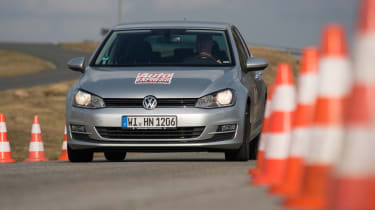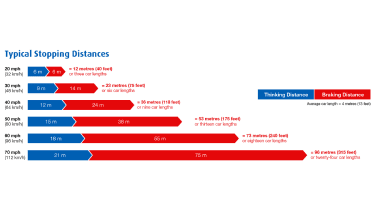Car stopping distances: everything you need to know
What is the braking distance when you stop from 30mph? 50mph? 70mph? Read our handy guide to car stopping distances to find out...
Car manufacturers, petrolheads, and even car mags all like to talk about how fast a car can accelerate – but what about how fast it can stop? Luckily, the highway code sets out some very clear guidelines for car stopping distances which are not only good to know from a safety point-of-view, they’re a vital part of the driving theory test.
• How to pass your driving theory test
The official average stopping distance is made up of two parts – thinking distance and braking distance. Both can be influenced by a variety of factors such as road conditions or driver impairment – so read on for our full guide to stopping distances.
What is stopping distance?
The Highway Code sets out a clear definition of the expected stopping distances from various speeds – as seen below:
As you can see, stopping distance as a whole is made up of two parts – thinking distance and braking distance. Thinking distance is the time between seeing a hazard and reacting by hitting the brakes.
Braking distance is the time between hitting the brakes and coming to a complete stop. Braking distance is more affected by speed than thinking distance is – the difference in thinking distance between 30-70mph is just 15m, while the difference in braking distance is 69m.
| Thinking distance | Braking distance | Total stopping distance | |
| 20mph | 6m | 6m | 12m or three car lengths |
| 30mph | 9m | 14m | 23m or six car lengths |
| 40mph | 12m | 24m | 36m or nine car lengths |
| 50mph | 15m | 38m | 53m or thirteen car lengths |
| 60mph | 18m | 55m | 73m or eighteen car lengths |
| 70mph | 21m | 75m | 96m or twenty-four car lengths |
What can affect stopping distance?
Stopping distance can be wildly different depending on a variety of factors. Some of these are:
Speed
As shown in the graph, higher speed equates to larger stopping distances. Thinking and braking distances both increase, and stopping distance is one of the main arguments for lowering speed limits to 20mph in town centres and built-up areas.
Road conditions
Wet or icy roads will increase braking distance, as there is less grip available on the road surface. The slippery road surface could result in the car skidding. In icy conditions braking distance can be increased by as much as ten times.
Driver impairment
Driving while drunk is against the law for several good reasons, and one of those is the effect it can have on thinking distance. Alcohol slows reaction times, reduces the ability to judge speed and distance, and increases fatigue, which means it will take longer for impaired drivers to react and start braking.
Tyres
The first factor relating to tyres is how good the tyres are in the first place – generally speaking, cheap tyres provide inferior stopping power compared to higher-quality units. The next is tyre condition – the law dictates that tyres must have a minimum of 1.6mm of tread depth across the middle of the tyre, and running with tyres below or close to this level will affect braking distance. It’s also important to keep your tyres pumped up to the correct pressure.

Even the type of tyres you buy can make a difference – in our tyre test last summer, there was a 4.6 metre difference in braking distance for the best and worst tyres.
Vehicle condition
It’s always a good idea to keep your vehicle in good condition – and certain essential maintenance can have a big effect on stopping distance. For example, a dirty windscreen could obscure hazards, leaving you less time to react for them. Poorly maintained brakes will take longer to bring the car to a complete halt, while dull or dirty headlights will illuminate less of the road and reduce visibility.
Distraction
Anything that leaves you distracted at the wheel will increase the thinking distance – hence the strong penalties for using mobile phones at the wheel. However it’s not just phones – messing with the radio or heater controls, talking to children in the backseat or eating are all acts that can affect your reactions.
All of these factors can affect how long it takes you to come to a complete halt – so, as always, drive carefully! Let us know what you think in the comments below...
Find a car with the experts



